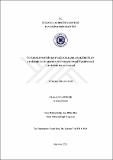DSpace Repository
ÜÇ FARKLI PROTEĠN KAYNAĞI KULLANILARAK ÜRETİLEN YENİLEBİLİR FİLMLERİN PEYNİR RAF ÖMRÜ ÜZERİNDEKİ ETKİSİNİN İNCELENMESİ
JavaScript is disabled for your browser. Some features of this site may not work without it.
| dc.contributor.author | Kaya Özkök, Gözde
|
|
| dc.date.accessioned | 2019-04-20T12:40:17Z | |
| dc.date.available | 2019-04-20T12:40:17Z | |
| dc.date.issued | 2017-06 | |
| dc.identifier.uri | http://hdl.handle.net/11547/1515 | |
| dc.description.abstract | Geri dönüşümlü filmler; sentetik ambalaj materyallerine alternatif, doğal ve çevre dostu olması ile artan ilgiyle odak noktası olmuştur. Filmler “yenilebilen, gıdayı koruyucu, ince katmanlı olarak uygulanan ve gıda ömrünü uzatan materyaller” olarak tanımlanmaktadır. Proteinler geri dönüşümlü ambalaj alanında en yaygın kullanıma sahiptirler. Fenolikler en çok meyvelerde bulunur ve önemli antioksidanları barındıran bu bileşenler insan sağlığı için önem arz etmektedir. Bu nedenle bu çalışmada amaç; üç farklı protein kaynağı olarak peynir altı suyu tozu proteini, soya proteini ve gluten proteini kullanılarak hazırlanan yenilebilir filmlerin özelliklerinin ve peynirin raf ömrü üzerindeki etkilerinin incelenmesidir. Filmlerin bir kısmı siyah üzüm süzüntüsü ile kombine edilerek hazırlanmıştır. Plastikleştirici olarak gliserin seçilmiştir. Çalışma için 15 g protein film sıvısı ve 3-3,5g peynir kullanılmıştır. Çalışmada oluşturulan filmler streç tabakada, ürüne yapışabilen, transparan sağlam ve elastik yapıda oluşmuştur. Soya proteini ve peynir altı suyu tozu proteini filmlerinin daha koruyucu ve nem kaybını dengeleyici olduğu görülmüştür. Üzüm suyu eklenen soya proteini ve peynir altı suyu tozu proteini filmlerinin peynir üzerindeki mikrobiyal gelişimine dirençli olduğu saptanmıştır. Gluten proteini filmi aralarında en viskoz özellik gösteren film olmuştur. Peynir altı suyu filmi ise aralarında en kalın filmi oluşturmuştur. Filmlere yapılan protein analizi sonuçlarında en fazla protein miktarı peynir altı suyu bazlı filmde, en az protein içeriği de soya proteini filminde bulunmuştur. | tr_TR |
| dc.language.iso | tr | tr_TR |
| dc.publisher | İSTANBUL AYDIN ÜNİVERSİTESİ FEN BİLİMLERİ ENSTİTÜSÜ | tr_TR |
| dc.subject | Peynir kalitesi | tr_TR |
| dc.subject | Yenilebilir film | tr_TR |
| dc.subject | Protein filmler | tr_TR |
| dc.subject | Antioksidan | tr_TR |
| dc.subject | Fenolikler | tr_TR |
| dc.subject | Cheese quality | tr_TR |
| dc.subject | Biodegradable films | tr_TR |
| dc.subject | Protein films | tr_TR |
| dc.subject | Antioxidant | tr_TR |
| dc.subject | Phenolics | tr_TR |
| dc.title | ÜÇ FARKLI PROTEĠN KAYNAĞI KULLANILARAK ÜRETİLEN YENİLEBİLİR FİLMLERİN PEYNİR RAF ÖMRÜ ÜZERİNDEKİ ETKİSİNİN İNCELENMESİ | tr_TR |
| dc.type | Thesis | tr_TR |
| dc.description.abstractol | Biodegradable films are the focus of an increasing interest as they represent a natural and environmental-friend alternative to synthetic packaging materials. They might be defined as “thin layers to protect and extend the shelf life of food products that are also able to be consumed with the food materials”. Proteins are among the most common materials for biodegradable packaging that are widely used. Phenolics are mostly found in fruits and they are significant antioxidants that are sufficient for human health. Therefore, this study is aimed to use three different sources of proteins: whey protein, soy protein and wheat gluten protein to investigate their properties and effects on sliced cheese samples‟ shelf life. Their combination with the grape juice addition was also tested. Glycerol was used as the plasticiser and the films are formed using suitable methods. Fixed amount of 15 g of protein films were added onto 3 -3.5 g cheese samples. The results of the study revealed that the films were elastic, adhesive, transparent and durable. Wheat gluten had the highest stretch and adhesive structure. Soy protein and whey protein films were found as the most protective since they decreased the moisture loss in the cheese samples. Grape juice added soy and whey protein films made the cheese samples more resistant to microbial growth. Combined usage of fruits with protein layers might be helpful to improve the cheese quality. Gluten protein film is the most viscous film amoung them. Whey protein based film is the most thickest film feature among them. The results of protein analysis on the films showed that the highest amount of protein was found in the whey based film and the lowest protein content was in the soy protein film. | tr_TR |
Files in this item
This item appears in the following Collection(s)
-
Tezler -Thesis [265]
